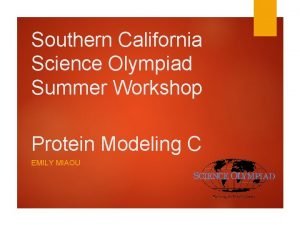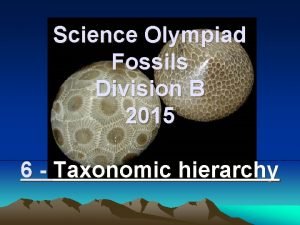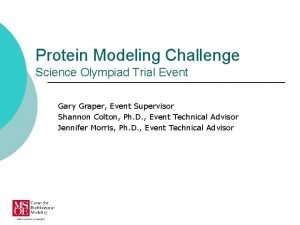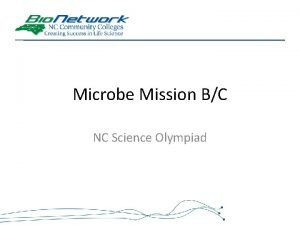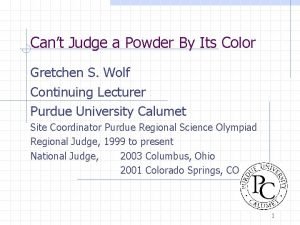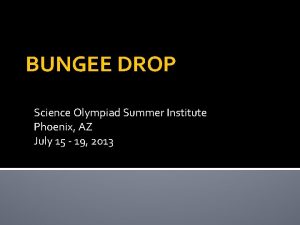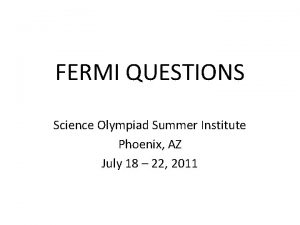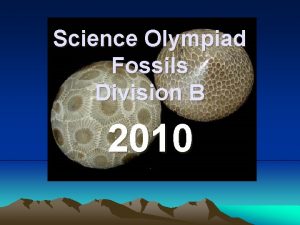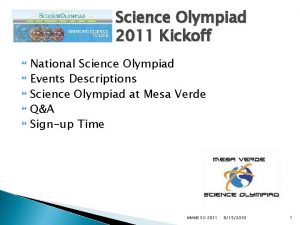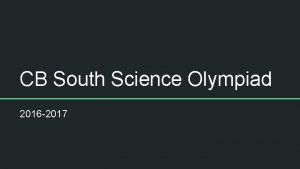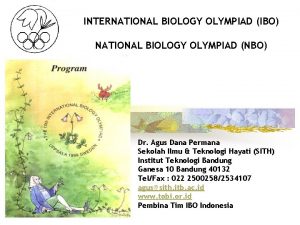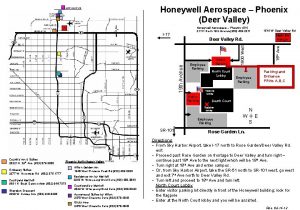EXPERIMENTAL DESIGN Science Olympiad Summer Institute Phoenix AZ






















- Slides: 22

EXPERIMENTAL DESIGN Science Olympiad Summer Institute Phoenix, AZ July 15 - 19, 2013

DESCRIPTION Determine a team’s ability to design, conduct, and report the findings of an experiment

PARAMETERS �STUDENTS (mandatory) ANSI Z 87 indirect vent chemical splash goggles Writing instrument(s) �STUDENTS (optional) Timepiece Ruler Any type of calculator NOTE: Chemicals requiring safety clothing will not be used.

THE COMPETITION Supervisors will provide teams with a blank copy of the Experimental Design Rubric Supervisors will provide teams with identical sets of materials If materials are given to teams in a container the container is considered part of the materials

COMPETITION (cont. ) Nature of the experiment is determined by a question/topic area assigned by Supervisor Same for all teams Allow for experiments involving independent and dependent variables

SCORING Experimental Design Rubric �Max. Pts. : B – 120 C - 126 �Tiebreaker Sequence 1. Variables 2. Procedure 3. Analysis of results 4. Graph 5. Data table � Teams not addressing the question/topic will be ranked behind others

a. Statement of Problem – 4 pts. Not a yes/no question Include independent and dependent variables 3. Problem is clearly testable 4. Written in a clear and concise manner 1. 2.

b. Hypothesis – 8 pts Predicts a relationship or trend Gives specific direction to the prediction 3. Includes both independent and dependent variables 4. Provides a rational for the hypothesis 1. 2.

c. i. Controlled Variables – 8 pts One point for each correctly defined constant 2. up to a maximum of 8 points 1.

c. i. i. Independent Variable – 6 pts 1. 2. 3. Operationally defined Correctly identified Has at least 3 levels

c. i. i. i. Dependent Variable – 6 pts 1. 2. Correctly defined (2 pts) Operationally defined

d. Experimental Control – 4 pts (where appropriate) 1. 2. Correctly identified Makes logical sense for the experiment

e. Materials – 6 pts 1. 2. 3. All materials used are listed No extra materials are listed Listed separately from procedure

f. Procedure – 12 pts Well organized In logical sequence Enough information is given to make experiment replicable 4. Includes diagrams 5. Has repeated trials 1. 2. 3.

g. Qualitative Observations – 8 pts Includes observations about 1. Results 2. Procedure/deviations from procedure 3. Results not relating to dependent variable 4. Things that happen during course of experiment VIDEO

h. Quantitative Data – 12 pts All raw data is provided All data has units Condensed table with most important data 4. Table is correctly labeled 5. Example calculations are include 6. Uses correct figures (significant figures included in C division) 1. 2. 3.

i. Graph(s) – 12 points 1. 2. 3. 4. 5. Appropriate type of graph Has a title Labeled correctly (2 pts) Units included Appropriate scale

j. Statistics – B 4/C 10 B Division – 2 pts 1. Uses average, median, or mode 2. Statistic used is appropriate for data C Division – B + 6 pts 1. Measure of central tendency 2. Measure of variation 3. Other appropriate statistic used

k. Analysis of Data – 8 pts All statements must be supported by data collected 1. All data is discussed and interpreted 2. Unusual data points commented upon 3. Trends in data explained 4. Enough detail provided to explain data

l. Experimental Errors – 6 pts 1. 2. 3. Reasons for errors Important information about data collection Effect of errors on data

m. Conclusion – 8 pts Hypothesis is evaluated by given data 2. Hypothesis is restated 3. Reasons to accept/reject hypothesis 4. All statements are supported by data 1.

n. Applications/Further Research – 8 pts 1. 2. 3. 4. Improvement of experiment Alternative interpretation of data Future experiments Practical application(s) of information discovered from experiment
 So cal science olympiad
So cal science olympiad Science olympiad summer institute
Science olympiad summer institute Msoe science olympiad
Msoe science olympiad Chem lab science olympiad
Chem lab science olympiad Experimental design science olympiad
Experimental design science olympiad Experimental vs non experimental
Experimental vs non experimental Experimental vs non experimental
Experimental vs non experimental Descriptive vs correlational vs experimental research
Descriptive vs correlational vs experimental research Experimental vs non experimental research
Experimental vs non experimental research Nonexperimental study
Nonexperimental study Phoenix online computer science university
Phoenix online computer science university Detector building science olympiad cheat sheet
Detector building science olympiad cheat sheet Science olympiad 2019 fossils
Science olympiad 2019 fossils International anatomy olympiad
International anatomy olympiad Science olympiad anatomy and physiology 2020 cheat sheet
Science olympiad anatomy and physiology 2020 cheat sheet Business modeling olympiad
Business modeling olympiad Science olympiad ornithology test
Science olympiad ornithology test Science olympiad solar system
Science olympiad solar system Microbe mission science olympiad
Microbe mission science olympiad Green generation science olympiad
Green generation science olympiad Science olympiad gravity vehicle
Science olympiad gravity vehicle Weather or not science olympiad
Weather or not science olympiad Can't judge a powder science olympiad
Can't judge a powder science olympiad


